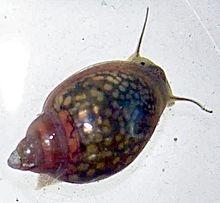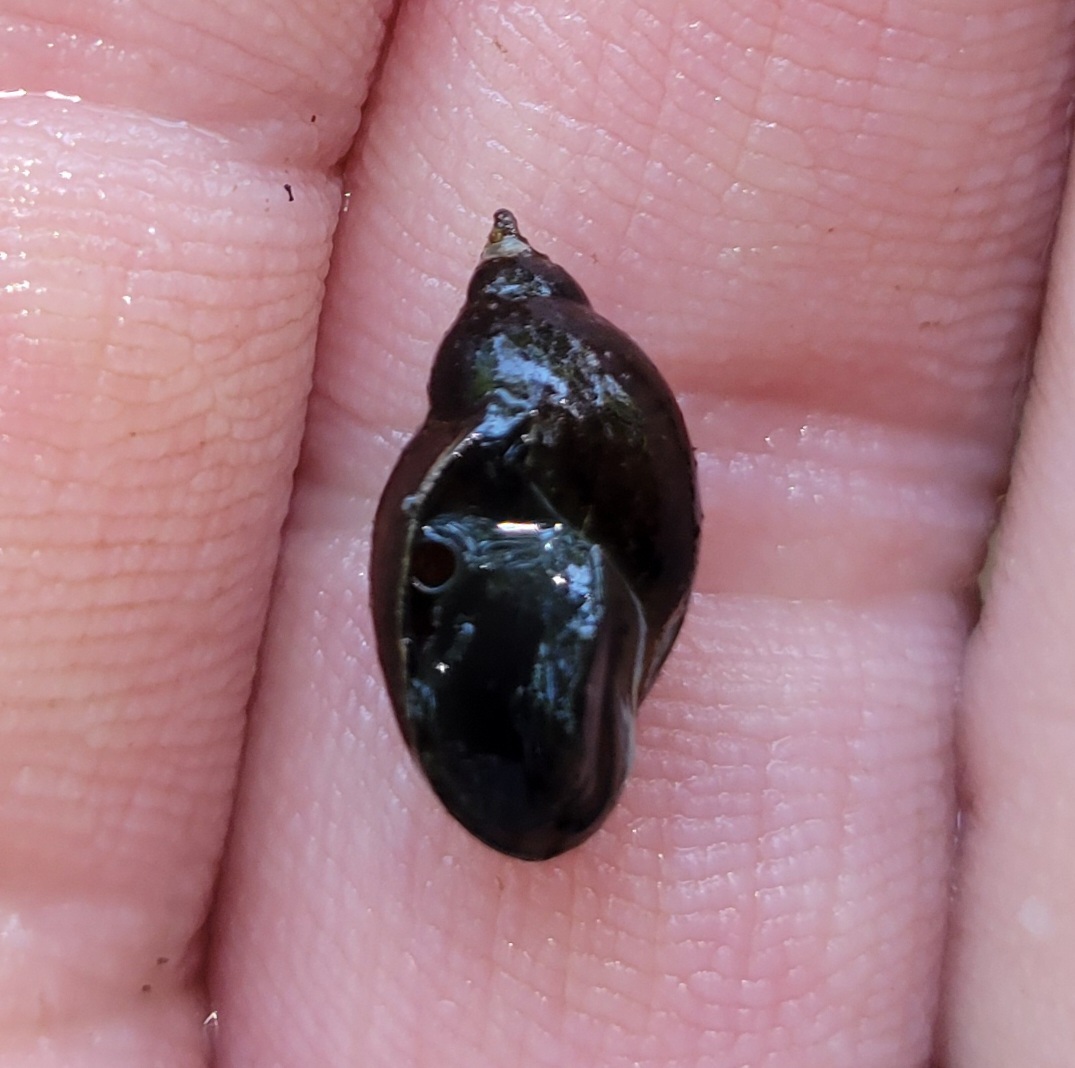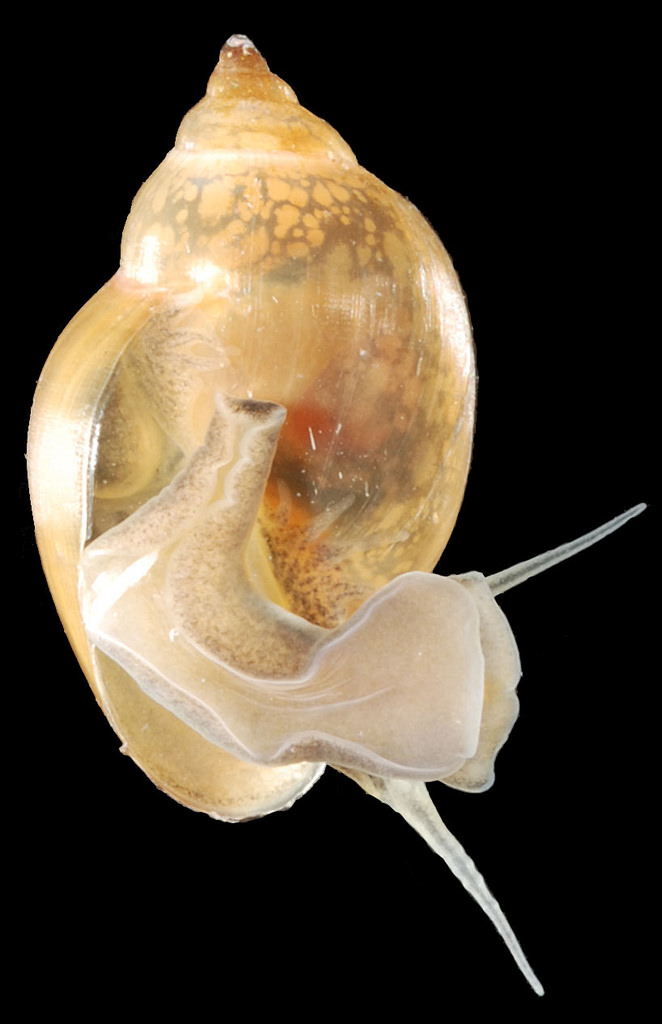Map Snapshot
























247 Records
Seasonality Snapshot
Source: Wikipedia
| Physella acuta | |
|---|---|

| |
| A live individual of Physella acuta | |
| Scientific classification | |
| Domain: | Eukaryota |
| Kingdom: | Animalia |
| Phylum: | Mollusca |
| Class: | Gastropoda |
| Superorder: | Hygrophila |
| Family: | Physidae |
| Genus: | Physella |
| Species: | P. acuta
|
| Binomial name | |
| Physella acuta (Draparnaud, 1805)[1]
| |
| Synonyms | |
|
Physa acuta Draparnaud, 1805 | |
Physella acuta is a species of small, left-handed or sinistral, air-breathing freshwater snail, an aquatic gastropod mollusk in the family Physidae. Common names include European physa, tadpole snail, bladder snail, and acute bladder snail.
Etymology
[edit]The name Physella means "little bladder", from Greek physa,[3] and the diminuative ending "-ella". This is in reference to the genus Physa, which P. acuta has, at times, been placed in. Acuta is a Latin word meaning sharp.[4]
Shell description
[edit]
Snails in the family Physidae have shells that are sinistral, which means that if the shell is held with the aperture facing the observer and the spire pointing up, then the aperture is on the left-hand side.
The shells of Physella species have a long and large aperture, a pointed spire, and no operculum. The shells are thin and corneous and rather transparent.
History
[edit]It was once thought that the indigenous distribution of Physella acuta is Mediterranean.[5][6] However, recent genetic analysis has revealed it to be the same species as Physella heterostropha of North America.[7] Researchers now increasingly consider P. acuta to be native to North America, so it may have only later been introduced to Europe.[8]
Distribution
[edit]The freshwater snail Physella acuta is common in all of North America and Europe including the United Kingdom. The species seems to have first spread through the Mediterranean regions and then more slowly into Northern Europe.[2][7] This species has been introduced into New Zealand and is widespread throughout both islands in ponds, lakes, and running water.[9] Physella acuta is presumed to occur also in Southern Africa.[10] Today, it can be found on all continents besides Antarctica.[8]
Beneficial Pests
[edit]Physella acuta is a relatively common freshwater aquarium pest. It usually spreads by laying its eggs on plants like Alternanthera reineckii, Leptochilus pteropus, or other small aquatic plants, which are then bought and taken home. Once in the tank, it becomes a non-harmful pest. Although Physella acuta can be annoying and reproduce quickly compared to other snails, they can actually be beneficial for your aquarium. They clean algae efficiently due to their speed and reproductive rate, and they help break down old food and feces, ensuring a healthier tank environment.
In the United Kingdom
[edit]Within the United Kingdom, P. acuta is considered to be an invasive species. It is prolific and has undergone naturalisation. P. acuta has been observed on several great Rivers, streams and tributaries within England, Wales, Scotland and Northern Ireland including the River Severn and the River Thames.[11] The ecological impact of this invasive species to the native floral and faunal species of the United Kingdom was assessed by the United Kingdom Technical Advisory Group (UKTAG) as "Unknown"[12] under the Water Framework Directive guidelines for Alien species.
In Europe
[edit]This species is found in:
- Belgium
- Serbia (it is especially abundant in the Drina river)
- Croatia
- Italy
- Czech Republic[13] – not evaluated (NE)[14]
- Slovakia[13]
- Germany[15]
- Netherlands[16]
- Pripyat River since 1983 and in Neman River basin in Belarus since 2007[7]
- Denmark
and others
The distribution also includes Mediterranean regions and Africa.[17]
In the Americas
[edit]The distribution includes the United States east of the Rocky Mountains[8]
- Cuba – native, the most common freshwater snail there alongside Tarebia granifera[18]
- Chile – invasive[19]
In Asia
[edit]Ecology
[edit]Habitat
[edit]This species lives in freshwater rivers, streams, lakes, ponds, and swamps.[17]
Physella acuta is frequently found in anthropogenic reservoirs, occurring in warm water discharges from power stations and in some rivers, but very rarely and not numerously in clay pit ponds. It can survive well under temporary harsh conditions (extreme temperature and water pollution), as long as they are short-lived.[7]
Feeding habits
[edit]These snails eat dead plant and animal matter and various other detritus.
Because Physella acuta forages mainly on epiphytic vegetation and on the macrophytes, whereas other gastropods (Planorbis planorbis, Radix ovata) exploit the algal cover or phytobentos on the bottom, competition between Physella acuta and other gastropods appears to be minimal.[7]
Interspecific relationship
[edit]This species successfully co-exists with other alien gastropods: for example with Potamopyrgus antipodarum in many streams, lakes and ponds in both New Zealand and the United Kingdom; and with Lithoglyphus naticoides in the Danube River.[7] The presence of P. acuta may encourage proliferation of invasive non-native macrophytes such as Nuttall's waterweed (Elodea nuttallii)
Predators
[edit]The bladder snail is a frequent prey of many snail-eating predators, such as
- Anomalochromis
- Badis badis
- Carinotetraodon travancoricus
- Puntius titteya
- Ambastaia sidthimunki
- Chromobotia macracanthus
- Clea helena[22][23][24]
- Sternotherus carinatus
- Glossiphonia weberi[22][25]
Reproduction
[edit]P. acuta is a self-compatible hermaphrodite. In natural populations, P. acuta preferentially reproduces by outcrossing.[26] When individuals from such populations self-fertilize they show a high degree of inbreeding depression. However, in experimentally constrained lines (where mates were often unavailable), after about 20 generations of self-fertilization, most of the inbreeding depression was purged.[26]
In the aquarium
[edit]P. acuta is one of a variety of snails often called "pest snails" in freshwater fishkeeping, due to their tendency to be inadvertently introduced into tanks via hitching a ride on ornamental plants, combined with how readily and quickly they reproduce due in part to their ability to self-fertilize. Others will however intentionally keep bladder snails, as their diet and ease of care can prove to make them a useful part of a tank's clean-up crew.
References
[edit]This article incorporates CC-BY-2.0 text (but not under GFDL) from reference.[7]
- ^ Draparnaud J.-P.-R. 1805. Histoire naturelle des mollusques terrestres et fluviatiles de la France. Ouvrage posthume. Avec XIII planches. pp. [1-9], j-viij [= 1-8], 1-134, [Plates 1-13]. Paris, Montpellier. (Plassan, Renaud).
- ^ a b c Dillon R. T., Wethington A. R., Rhett J. M. & Smith T. P. 2002. Populations of the European freshwater pulmonate Physa acuta are not reproductively isolated from American Physa heterostopha or Physa integra. Invertebrate Biology, 121: 226-234. (abstract)
- ^ "Definition of PHYSA". www.merriam-webster.com. Retrieved 2024-11-05.
- ^ "Latin Definition for: acutus, acuta (ID: 696) - Latin Dictionary and Grammar Resources - Latdict". latin-dictionary.net. Retrieved 2024-11-05.
- ^ (in Slovak) Lisický M. J. (1991). Mollusca Slovenska [The Slovak molluscs]. VEDA vydavateľstvo Slovenskej akadémie vied, Bratislava, 344 pp.
- ^ Glöer, P. 2002 Die Süßwassergastropoden Nord- und Mitteleuropas. Die Tierwelt Deutschlands, ConchBooks, Hackenheim, 326 pp., ISBN 3-925919-60-0, page 238-239.
- ^ a b c d e f g Vitaliy Semenchenko, Tatiana Laenko & Vladimir Razlutskij. 2008. A new record of the North American gastropod Physella acuta (Draparnaud 1805) from the Neman River Basin, Belarus. Aquatic Invasions (2008) Volume 3, Issue 3: 359–360.
- ^ a b c Morningstar; Daniel (2021). "Acute bladder snail (Physella acuta) - Species Profile". USGS Nonindigenous Aquatic Species Database. Retrieved 2024-11-05.
- ^ "Freshwater Pests of New Zealand" (PDF). NIWA. 2013.
- ^ Rapalai, B.L. (2024). "An annotated checklist of molluscs recorded from Botswana". Indago. 41: 15–44. doi:10.5281/zenodo.13132605.
- ^ "Physella acuta | NBN Atlas".
- ^ "European physa, Physella acuta - GB non-native species secretariat".
- ^ a b (in Czech) Horsák M., Juřičková L., Beran L., Čejka T. & Dvořák L. (2010). "Komentovaný seznam měkkýšů zjištěných ve volné přírodě České a Slovenské republiky. [Annotated list of mollusc species recorded outdoors in the Czech and Slovak Republics]". Malacologica Bohemoslovaca, Suppl. 1: 1–37. PDF.
- ^ Beran, L. (2002) Vodní měkkýši České Republiky – rozšíření a jeho změny, stanoviště, šíření, ohrožení a ochrana, červený seznam. Aquatic molluscs of the Czech Republic – distribution and its changes, habitats, dispersal, threat and protection, Red List. – Sborník přírodovědného klubu v Uherském Hradišti, Supplementum 10, 258 pp. (in Czech)
- ^ MollBase – Physella acuta – Spitze Blasenschnecke – Verbreitungsatlas Schleswig-Holstein 1991
- ^ "Physella acuta". 2005.
- ^ a b Amy Benson. 2007. Physella acuta. USGS Nonindigenous Aquatic Species Database, Gainesville, FL. https://nas.er.usgs.gov/queries/FactSheet.asp?speciesID=1025 Revision Date: 4/22/2004
- ^ Vázquez A. A. & Perera S. (2010). "Endemic Freshwater molluscs of Cuba and their conservation status". Tropical Conservation Science 3(2): 190–199. HTM, PDF.
- ^ Collado, Gonzalo A. (March 2017). "Unraveling cryptic invasion of a freshwater snail in Chile based on molecular and morphological data". Biodiversity and Conservation. 26 (3): 567–578. Bibcode:2017BiCon..26..567C. doi:10.1007/s10531-016-1255-y. ISSN 0960-3115. S2CID 34260702.
- ^ Paul, P.; Aditya, G. (2021-05-04). "Invasion of the freshwater snail Physella acuta (Draparnaud, 1805) in selected ponds of North Dinajpur, India". Journal of Environmental Biology. 42 (3): 577–581. doi:10.22438/jeb/42/3/mrn-1628. ISSN 0254-8704.
- ^ a b Vinarski, Maxim V. (2017-04-01). "The history of an invasion: phases of the explosive spread of the physid snail Physella acuta through Europe, Transcaucasia and Central Asia". Biological Invasions. 19 (4): 1299–1314. Bibcode:2017BiInv..19.1299V. doi:10.1007/s10530-016-1339-3. ISSN 1573-1464. S2CID 254292899.
- ^ a b Paul, Pranesh; Das, Rajat; Nandy, Gargi; Aditya, Gautam (2022-10-25). "Preferring what others avoid: differences in the vulnerability of freshwater snails to the exotic and native predators". Hydrobiologia. doi:10.1007/s10750-022-05062-w. ISSN 1573-5117. S2CID 253133418.
- ^ Karmakar, R.; Paul, P.; Aditya, G. (2022-03-11). "Predation and prey preference of the exotic snail Anentome helena on two freshwater snails: implications for species invasion". Journal of Environmental Biology. 43 (2): 293–298. doi:10.22438/jeb/43/2/mrn-2048. ISSN 0254-8704.
- ^ Paul, Pranesh; Mondal, Debasish; Aditya, Gautam (2022-03-01). "Influencing the way they compete: Exotic predator mediated non-consumptive effects on two co-occurring freshwater snails". Aquatic Ecology. 56 (1): 285–298. Bibcode:2022AqEco..56..285P. doi:10.1007/s10452-021-09918-6. ISSN 1573-5125. S2CID 254189482.
- ^ Paul, Pranesh; Karmakar, Rupsha; Chatterjee, Swagata; Barua, Ankita; Banerjee, Sampa; Aditya, Gautam (2021-12-01). "Predation of Glossiphonia weberi (Blanchard, 1897) on the invasive snail Physella acuta (Draparnaud, 1805) in the presence of an alternative prey". Limnological Review. 21 (4): 201–208. doi:10.2478/limre-2021-0019 (inactive 15 November 2024). ISSN 2300-7575. Retrieved 15 November 2024 – via MDPI.
{{cite journal}}: CS1 maint: DOI inactive as of November 2024 (link) - ^ a b Noël E, Chemtob Y, Janicke T, Sarda V, Pélissié B, Jarne P, David P. Reduced mate availability leads to evolution of self-fertilization and purging of inbreeding depression in a hermaphrodite. Evolution. 2016 Mar;70(3):625-40. doi: 10.1111/evo.12886. Epub 2016 Mar 9. PMID 26899922
Further reading
[edit]- Naranjo-García E. & Appleton C. C. (2009). "The architecture of the physid musculature of Physa acuta Draparnaud, 1805 (Gastropoda: Physidae)". African Invertebrates 50(1): 1-11. Abstract
External links
[edit]- Physa acuta at AnimalBase taxonomy,short description, distribution, biology,status (threats), images
- https://web.archive.org/web/20071007012447/http://www.aquarium-kosmos.de/inhalt/50/blasenschnecken-physella-acuta


